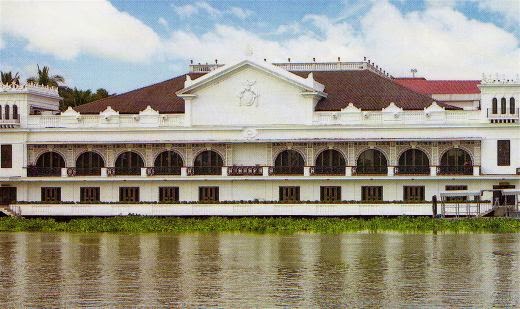
The National Museum of the Philippines (Filipino: Pambansang Museo ng Pulpiness) is the official repository established in 1901 as a natural history and ethnography museum of the Philippines. The museum complex is located next to Rizal Park and near Intramural in Manila. It houses the Spoliarium, a famous painting of Juan Luna. The National Museum Complex is composed of four different establishments concentrating on four different fields of arts and science, namely, Philippine Arts, Anthropology & Archaeology, Natural History, and Planetary & Space Science.
The National Art Gallery is housed in the old congress building. The building was originally intended as a Public Library as proposed in Daniel Burn ham's 1905 Plan for Manila. Designed by Ralph Harrington Doane, the American consulting architect of the Bureau of Public Works, and his assistant Antonio Toledo. Construction of the building began in 1918 and completed in 1921.
The facade of the building had classical features using stylized Corinthian columns, ornamentation and Renaissance inspired sculptural forms. Upon the establishment of the Commonwealth government, it was decided that the building would also house the Legislature and revisions were made by Juan Ariella, supervising architect of the Bureau of Public Works.
On July 16, 1926, the building was formally inaugurated. During the World War II, the building was heavily damaged, though built to be earthquake resistant.After the war, it was rebuilt albeit less ornate and less detailed. During the Martial Law era, the Legislative Building was closed down. Today, the building holds the country's National Art Gallery, natural sciences and other support divisions.
Malacañang Palace, formally Malacañan Palace or the Palace, is the official residence, but not the direct residence and principal workplace President of the Philippines. The palace is situated on the banks of the Pasig River, and the address is in the 1000 Jose P. Laurel Street, district of San Miguel, Manila. Malacañang was built in 1750 by the Spanish Colonial style. Since the days of Rafael DE Echague y Birmingham, it became the residence of every head of government of the Philippines. During the colonial period of the United States, the Governor General Francis Burton Harrison and Dwight F. Davis building Kalayaan Hall executive in this place, which is now used as a museum.
Unlike the neighboring Phi Si an Temple, the Taoist temple is open to the worshipers and non-worshipers alike. A ritual among devotees is where one prays to the gods to grant one's wish. The ritual includes washing of hands, going inside the chapel barefoot and dropping two blocks of wood. If the blocks of wood are both face up then one could make a wish. If not then it is not yet the time for one's wish to be granted and one has to come to the temple some other time.
The temple is the center of worship for Taoism, the religion which follows the teachings of the ancient Chinese philosopher, Lao Zi. Another ritual among Taoist devotees, which is done during Wednesdays and Sundays, is the climbing of its 81 steps (representing the 81 chapters of Taoism scriptures) to light joss sticks and have their fortune read by the monks.
Some guide books and travel agencies offer trips to the temple or as a side-trip in a tour around Cebu City. But it is more popular with grade school students.
The entrance to the temple is a replica of the Great Wall of China. The temple includes a chapel, a library, a souvenir shop and a wishing well. The spacious balconies offer a scenic view of the downtown Cebu.
Enchanted Kingdom abbreviated as EK is a theme park in the Philippines. It is located in Santa Rosa City, Laguna, about 39 kilometers (24 mi) from Manila. It has a land area of 17 hectares (41 acres). The park is managed and operated by Enchanted Kingdom Inc.




















0 comments:
Post a Comment